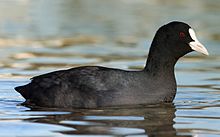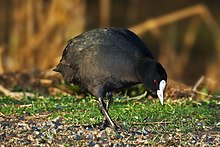Eurasian coot: Difference between revisions
added wikispecies links |
JJ Harrison (talk | contribs) No edit summary |
||
| Line 21: | Line 21: | ||
__TOC__ |
__TOC__ |
||
==Range and habits== |
==Range and habits== |
||
[[Image:Eurasian Coot.jpg|thumb|right|Feeding in Tasmania, Australia]] |
|||
The Coot breeds across much of the [[Old World]] on freshwater lakes and ponds. It is resident in the milder parts of its range, but [[bird migration|migrates]] further south and west from much of Asia in winter as the waters freeze. |
The Coot breeds across much of the [[Old World]] on freshwater lakes and ponds. It is resident in the milder parts of its range, but [[bird migration|migrates]] further south and west from much of Asia in winter as the waters freeze. |
||
[[Image:Fulica atra Luc Viatour.jpg|thumb|left|detail]] |
[[Image:Fulica atra Luc Viatour.jpg|thumb|left|detail]] |
||
Revision as of 09:46, 30 September 2008
| Eurasian Coot | |
|---|---|

| |
| Fulica atra, adult | |
| Scientific classification | |
| Kingdom: | |
| Phylum: | |
| Class: | |
| Order: | |
| Family: | |
| Genus: | |
| Species: | F. atra
|
| Binomial name | |
| Fulica atra | |
| Synonyms | |
|
Fulica prior | |

The Eurasian Coot, Fulica atra, also known as Coot, is a member of the rail and crake bird family, the Rallidae.
Range and habits

The Coot breeds across much of the Old World on freshwater lakes and ponds. It is resident in the milder parts of its range, but migrates further south and west from much of Asia in winter as the waters freeze.


The Coot is much less secretive than most of the rail family, and can be seen swimming on open water or walking across waterside grasslands. It is an aggressive species, and strongly territorial during the breeding season.
It is reluctant to fly and when taking off runs across the water surface with much splashing. They do the same, but without actually flying, when travelling a short distance at speed in territorial disputes. As with many rails, its weak flight does not inspire confidence, but on migration, usually at night, it can cover surprisingly large distances. It bobs its head as it swims, and makes short dives from a little jump.
The Coot is 36-42 cm long, and is largely black except for the white facial shield (which gave rise to the phrase "as bald as a coot"). As a swimming species, the Coot has partial webbing on its long strong toes.
The juvenile is paler than the adult, has a whitish breast, and lacks the facial shield; the adult black plumage develops when about 3-4 months old, but the white shield is only fully developed at about one year old, some time later.

This species builds a nest of dead reeds and grasses near the water's edge or on underwater obstacles protruding from the water, laying up to 10 eggs, though usually only 3 survive because of the parents brutal behaviour. [1]
Coots can be very brutal to their own young under pressure such as the lack of food. They will bite young that are begging for food and repeatedly do this until it stops begging and starves to death. But if the begging keeps going, then they may even bite so hard that the chick is killed.
The Coot is an omnivore, and will take a variety of small live prey including the eggs of other water birds.
This is a noisy bird with a wide repertoire of crackling, explosive or trumpeting calls, often given at night.
The Eurasian Coot is one of the species to which the Agreement on the Conservation of African-Eurasian Migratory Waterbirds (AEWA) applies.
Gallery
-
Nest in Hyderabad, India.
-
Juvenile in Hyderabad, India.
-
Immature in Hyderabad, India.
-
Family in Hyderabad, India.
-
Adult feeding juvenile in an Indian Lotus Nelumbo nucifera pond in Hyderabad, India
-
Parent feeding its chicks
-
Coot nest and eggs near a British lake.
-
London, with three chicks
-
The facial shield head-on
-
On a frozen lake
Sounds
- Eurasian Coot Call (WAV file)
- Eurasian Coot Call (OGG file)
References
- ^ Attenborough, David, Life of Birds, ISBN 978-0691016337.
- Template:IUCN2006 Database entry includes justification for why this species is of least concern.
External links
- Eurasian Coot videos on the Internet Bird Collection
















